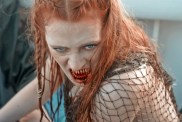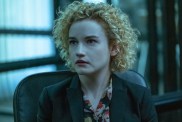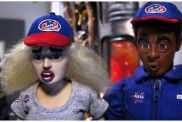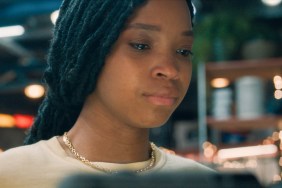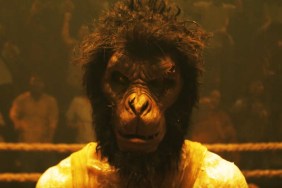The 1980s produced more cheese than the entire state of Wisconsin put together, but it also produced a number of movies that are considered beloved classics. Somewhere in between those extremes is Clash of the Titans, the 1981 epic directed by Desmond Davis and starring the likes of Laurence Olivier, Maggie Smith and Ursula Andress as the Greek Gods on Mount Olympus and Harry Hamlin as Perseus, a great warrior and the son of Zeus who is put through a series of tests to rescue the Princess Andromeda before she’s sacrificed to the fiercest monster imaginable. The movie featured some of Ray Harryhausen’s great stop-motion creatures and an annoying mechanical owl named Bubo, but for many people, it was also their first introduction of Greek mythology, so it’s no wonder that 28 years later, enough execs at Warner Bros. remembered it fondly enough to realize what prime fodder it was for the remake treatment.
Of course, the skeptical amongst us immediately assumed the success the studio had with Zack Snyder’s 300 led them to want to do more swords-and-sandals epics, and that’s probably true enough, but under the guidance of director Louis Leterrier, who went to great pains to implement images from the comic books into his previous movie The Incredible Hulk, one imagines his remake of Clash of the Titans would be something that was reverential to the original but with his own sense of scale and scope.
To give ComingSoon.net readers a taste of what to expect, we were flown by Warner Bros. to Jolly Ol’ England, specifically to Longcross Studios where we’d ultimately end up standing in a recreation of the plaza of the city of Argos, watching the French filmmaker yelling out numbers at a mob of background actors running around the set completely panicked at the arrival of… The Kraken!
But that would be much later in the day. On our arrival, we were brought to a press tent adorned with photos of the film’s extensive cast of characters, while the film’s unit publicist Mira Husseini was nice enough to fill us in on the backstory before Perseus begins his grand quest. (If you don’t already know the general story of the first “Clash” or are completely unfamiliar with Greek mythology and don’t want to be spoiled, you might want to skip the next few paragraphs.)
We were told the story takes place in a world created by Gods who aren’t as clear-cut as being good or evil, but instead have their own way of doing things, which relies heavily on them being honored and praised by the people of the world for them to grant their favors.
This particular story begins with Zeus (Liam Neeson), the mightiest of the Gods, lusting after Crete’s Queen Danae, played by Danish model Tine Staplefeldt, so he disguises himself as her husband, King Acrisius, and they get it on. When the real Acrisius, played by Jason Flemyng, finds out what happened, actually walking in on them, he gets so angry at Danae he puts her in a coffin and throws her into the ocean where she gives birth to Perseus. A fisherman and his wife (Pete Postlethwaite, Elizabeth McGovern) rescue the young Perseus from the floating coffin and raise him as their own, all oblivious to the fact that he’s the spawn of a God.
After something happens to his adopted parents, the grown-up Perseus, played by Sam Worthington, star of Avatar and Terminator Salvation, makes his way back to Argos and learns how much the place has changed. In response to Acrisius’ actions, Zeus has struck him with a lightning bolt that transforms the former king into the hideous creature Calibos. Meanwhile, the people of the city have become unhappy with the way they’re living in poverty and have rebelled against their dependence on the Gods, something that does not make their benefactors very happy. Hades, God of the Underworld, played by Ralph Fiennes (Voldemort from the “Harry Potter” movies) appears before them and threatens to destroy the city unless they sacrifice the fair Princess Andromeda to the fierce beast, the Kraken.
Already having a chip on his shoulder about the Gods, Perseus agrees to lead a band of warriors, including the Argos Honor Guard and its leader Draco (Mads Mikkelsen), to defeat the Kraken and save Andromeda. Along the way, they’re joined by other warriors, all of whom Hades tries to hinder by sending his creatures against them; more about them below.
After that quick overview, we were taken to a trailer where we were shown a sizzle reel of footage that had been shot before our arrival, something which gave us a good idea of the production so far and the look they were going for with the movie. The reel included timelapse footage of one of the larger sets being built and pre-vis animatics of Hades’ Harpies exploding out of the water to attack a ship, as well as a few scenes that harked back to the original like the statue of Poseidon toppling into the sea, plus there were portrait shots of all the characters in the epic adventure, including the Gods, all decked out in shiny armor, except for Hades, played by Ralph Fiennes, who has a much different look, wearing darker, dirtier clothes being that he lives under the earth. (You can see some of this footage in the two trailers released so far.) One of the more impressive scenes was the last shot, an amazing visual of the journeymen walking across mountains so high in the atmosphere that the clouds were wafting at their feet, which we would learn more about later.
After watching the sizzle reel, we had a chance to talk with producer Kevin De La Noy, who was the executive producer on The Dark Knight and a production manager on Titanic. You can read that insightful interview here.
Band of Brothers… and One Sister

In Leterrier’s version of “Clash,” we don’t just have Perseus followed by an army of faceless, nameless soldiers who are basically fodder for whatever creatures they face. Instead, they are people with different personalities and from different backgrounds that should add greatly to the story.
The most prominent member of the group that’s been dubbed “the journeymen” is in fact the only woman in the group, Gemma (Quantum of Solace) Arterton’s Io, a mystical, eternal being who joins the band as a spiritual advisor and a protector for Perseus, having been aware of his plight since birth.
Danish actor Mads Mikkelsen (Casino Royale) plays Draco, head of the Honor Guard, looking particularly tough with a beard and a prominent scar on his face, who begrudgingly goes on Perseus’ quest, although it goes against his own ideas on how to save Andromeda.
7′ 2″ (!) Ian Whyte plays the most intriguing member of the group, Sheikh Suleiman, a giant warrior from a mysterious Djinn, a desert tribe who uses tree bark as armor to the point where they’ve replaced most of their flesh with wood, making them more plant than human. He’s also able to exert some sort of mystical control over the giant scorpions, the Scorpioks, the group encounters, which allows them to use one for transport, placing a palanquin on its back to carry them across the world.
The rest of the journeymen include Hans Matheson as Ixas, Irish actor Liam Cunningham as Solon, Nicholas Hoult and two Turkish brothers they meet on the trip who offer a comedic element to the journey as they try to one-up each other. The latter were the only ones working on the day we visited the set, so you’ll have to see the movie to find out what the rest of them bring to Perseus’ journey… and whether they survive the experience.
Creating the World

We were then brought into the production offices and a room where the walls were covered with conceptual art used to help figure out the visual aesthetic for the film, which included many gorgeous and fantastic paintings of the main locations used as basis for designing them.
A lot of the work that went into creating this world involved bringing the production to a number of locations including three very rainy and muddy weeks in Wales and filming in Tenarife, as mentioned above. Besides Longcross, the production took over stages at two other local studios, Shepperton and Pinewood, where they had built some of the larger sets like the Stygian Witches’ Lair, the Olympus Throne Room, meeting place of the Gods, and the Basilica in Argos where many key sequences take place. The concept art for Mount Olympus was quite stunning, really looking like a heavenly place where the Gods might reside. Similarly, the city of Argos is also quite immense, literally covering the entire side of a mountain, although they built a large section of it in the backlot of Longcross, which we’d have a chance to see later.
Designing and painting these places was one thing but then they had to figure out locations that could duplicate as them and the logistics of building the necessary sets where locations wouldn’t work. De La Noy’s experience as a location scout helped with the former and then it was up to the production design and creative teams to figure out how to create the other places.
The Stygian mountains were shot at a slate quarry in Wales, combined with a cavern set where the witches reside; in the concept art, it looked like an outcrop shaped like a hand that we were told was meant to represent the hand of a fallen Titan. Medusa’s Lair posed some interesting problems because it was so large and it involved the band of warriors climbing upwards through the cave, and each section had to be constructed, filmed, then torn down for the next section.
The earlier scene we saw in the sizzle reel of the journeymen looking across mountains that jutted out through the clouds was shot in Tenerife in Spain’s Canary Island, and it literally took half a day to get up there in order to shoot.
The Sets:
Unfortunately, we couldn’t see a lot of what we mentioned above firsthand, either because they were in different studios or places, but at Longcross, the biggest set that had been built was the central plaza of the city of Argos where most of the action was taking place that day. As mentioned above, they only created one part of it with the rest of it being completed by visual FX. We had seen something of a similar scale when we visited the set of Harold Ramis’ Year One a few years back, but this was much more massive, especially with the large archway towering over the main square which had two sets of stairs leading up to it. From the center square, there were two streets that stretched out, both of them dressed up as an active village that can be used for whatever shot Leterrier wanted at any given time, including a market complete with all sorts of figs and nuts and dates, and a couple of BBQ pits that were used for cooking.
Part of the group’s journey takes them down the River Styx, and we got a chance to see Charon’s ferry, one of those rare cases where set design and creature FX are one, because they had affixed an animatronic version of Charon to the ship’s bulkhead and as we arrived, the technicians were giving it a test run showing how his minimal facial features could be controlled electronically. Even though they hadn’t quite finished building that set, we could see that it was mounted on tracks on one end of the immense soundstage so that it could be pulled across to create movement. Next, we were taken onto another nearby soundstage where they’d constructed the underside of the boat where Perseus and Io have a moment among the coins hoarded by Charon. This was a much more confined space that one might imagine from the size of the ferry.
Featured Creatures

While the original movie had the magic of Ray Harryhausen creating most of the creatures, Leterrier’s uses a combination of cutting-edge CG, traditional make-up effects, prosthetics and animatronics to create the creatures. (As we learned, no one involved with the movie ever calls them “monsters” because in most cases, these were once humans who had been transformed by the Gods.) This required the close interaction between different departments, all pulled together by special effects supervisor Neil Corbould, who actually worked on the original movie when he was just 15 years old!
Just like in the original, the largest creature will be the beast known as the Kraken that Zeus unleashes on the city of Argos, although in this case, it’s going to be absolutely immense and will be done all in CG rather than looking like a giant lump of moving clay green-screened onto the background of the set. You can get some idea what it will look like from the trailers and posters released so far, but it was pretty intense to see in model form with all of its tentacles and its taloned 3-finger hands.
The myth of the Medusa was that she once was a beautiful woman before being turned into the snakewoman whose gaze turns those who look into her eyes to stone. That might have been why they cast Russian supermodel Natalia Vodianova in the role, although they might just be using her as reference or for close-ups, since the plan is for Medusa to be a fully CG creature with a much longer reptilian tail than the one in the original movie.
The Harpies, the bat-like creatures of Hades that come flying from the Underworld to annoy our heroes, were mainly going to be created using CG. In the creature workshop, they had created a number of physical Harpies made out of foam and fiberglass over a metal frame for certain sequences. They showed us some of the maquettes used for designing Medusa’s head and Charon’s face, as well as various models of the Kraken and harpy that were used for reference in the various departments.
Other things of interest in the creature shop included the stone version of soldiers who had fallen victims to Medusa’s gaze, and a prominently displayed chart on the wall that helped the SFX department figure out the iPod rotation so that everyone working there had a fair chance to choose the accompanying music. (We were all quite amused by that.)
The winged horse Pegasus is also a combination of things, using a real horse with CG wings for certain scenes and an animatronic version of it for others. We were somewhat surprised to learn that there may be more than one Pegasus in the movie, although there’s only one hero version ridden by Perseus, much to the chagrin of Worthington who didn’t get along with the horse apparently. (Read his interview to learn more about that.)
Although there’s been some questions about whether the clockwork owl Bubo who appeared in the original movie would show up this time around, they did surprise us by showing us the new version of Bubo they created for the movie, probably more for a cameo role, which had a moving head, eyes that rolled and wings that flapped. (They tried to get the original but the person who owns it wouldn’t let it out of his steely grasp.)
Earlier, we spent some time talking to Conor O’Sullivan in the prosthetics department, who designed Heath Ledger’s make-up as the Joker for The Dark Knight, and he showed us some of the prosthetics and make-up used to create the creatures that weren’t going to mainly be done in visual effects. One of the biggest jobs was to design the look for Jason Fleming’s half-man half-beast Calibos, who wields a giant ugly scar down the center of his face where he had been struck by Zeus’ lightning, and then the rest of his body is morphed into hideous shapes. Make-up effects were also heavily used in creating the Stygian Witches, the three oracles whom share a single eyeball between them and are played by three actresses in full-body prosthetics and make-up, which included wearing extremely ugly sagging boobs, something that generated quite a bit of chortling. Similarly, the prosthetics department had helped create the lost souls that would reside in Charon’s domain. Conor also talked about how they created the bark-like masks and full-body armor for Sheikh Suleiman and his tribe, and how they perfected a new system for applying prosthetics that allowed them to turn Ian Whyte into his character far quicker than it might normally take to do such an intricate make-up job on a daily basis. He also said that most of the creatures being handled by prosthetics would not require a lot of additional CG, but he shared his regrets that so much of what they used to do using prosthetic and make-up is now being replaced with CG.
“Feel How Heavy/Light This Is…”

Next stop were the weapons and props department where the above statement became the central theme as suggested repeatedly to us by the film’s armorer Nick Komornicki, who took great pains to create authentic-looking weapons that had the proper weight and strength of real weapons when used in battle, but also creating lighter rubber replicas for the cast to carry around when it wasn’t as important to get that feel.
Because they’re going for more historic realism in this take on “Clash” than the original, they put a lot of time into designing the proper costumes, weapons and accouterments that the journeymen would each be carrying, typical of the region and era from which they came. Komornicki, who previously worked on Wolfgang Peterson’s Troy, told us they used roughly 10% of that production’s Greek weapons for “Clash” but his team of four people still ended up designing and manufacturing roughly 1,600 different items for the movie over three months after being hired for the job.
Most of the swords carried by the Argos soldiers were made out of bronze, which were super-heavy, so they decided to go for shorter blades because longer ones would have been almost impossible for the actors to wield. Essentially, they used metal swords when necessary for dramatic effect, but the rubber ones looked convincing enough that they could be used in longer shots. Nick told us that Louis and some of the actors were getting a little weapon-crazy piling themselves up with every conceivable weapon to make sure they were ready for anything, only to realize how hard it was to carry all of it around in the walking scenes.
The wooden Djinn tribe didn’t have anything made from metal, instead using throwing swords made out of wood and bone, molded out of something called “Chemiwood.” One of the Turkish brothers had a giant hammer with a blade on one end of it, which looked pretty cool. (Nick told us a story about one of them inventing his own weapon, essentially a big rock slung on a leather strap, which nearly caused a painful accident when he fell over while carrying it.)
One major difference in this version of “Clash of the Titans” is that even the Gods are armed, and we got to see (and weigh) a lot of their weapons, which were far more intricate in design than those of their human counterparts, giving Nick and his crew a little more room to experiment in trying to create weapons that looked good with the armor created by the costume department. These included Zeus’ impressive sword, Apollo’s staff and Ares’ war hammer, none of which necessarily would be used in fight scenes but were there mainly for show. Apollo also gives a baton to Perseus, which morphs into a fancy sword when he picks it up, something done in conjunction with visual FX.
Some of the creatures also needed to be armed, including Calibos, who has a very distinctive-looking forked sword, one that was practically split in two when he was struck by Zeus’ lightning – Nick showed us Acrisius’ original sword as well. Of course, Medusa has her bow, which was suitably ornate with a similar snake motif. Although they had created a physical version of the bow, it was scanned by the visual FX guys to use for the CG Medusa.
The movie’s resident props master Jamie Wilkinson was busy on set while his assistant Quentin Davis tried to show us some of the props that weren’t being used. He explained how the department had just finished making hundreds of piles of gold coins used to dress up the ferry interior we saw earlier, and there were still lots of unused prototypes laying around, mostly stacks of chocolate coins, similar to the ones they used for Gringott’s bank in the first “Harry Potter” movie.
He then brought us into a special locked-off section of the workshop where they kept all the “Hero Props,” things like Poseidon’s metal trident which was insanely heavy, and Apollo’s staff which was made out of bronze, compared to Suleiman’s staff was a tree branch, of course. There even was a “hero coin” being the one that Perseus gives to Charon.
There certainly seemed to be a bit of a grey area in the production between the items handled by props and those handled by Komornicki’s team. For instance, props were in charge of Medusa’s arrows, while the bow was designed by the armorers; props also were responsible for some of the shields, particularly the ones that weren’t made out of metal, and they had a few different shields on display, including the ones with the three-serpent crest of the Argos army. Perseus’ shield is actually made out of the armored hide of one of the Scorpioks he kills earlier in the movie, literally bursting out of it after being swallowed.
The props department had built a number of coffins for the scene of Perseus’ mother Danae being thrown into the sea, of all different sizes depending on the way Leterrier might want to shoot it. Also in this area were the game board figurines the Gods use to keep track of the people on Perseus’ quest and the creatures they encounter, and the golden chains used to attach Andromeda to the rock as sacrifice to the Kraken. We also were shown an assortment of goblets, and an actual lyre (a stringed Medieval instrument) that was used in the Basilica scenes.
“Release the Kraken!” Already

Towards the end of the day, we finally had a chance to watch a bit of filming on the main set, that Argos city scene we mentioned earlier, and yes, we actually got to see what happens when Zeus releases the Kraken, more or less.
The place was flooded with hundreds of background actors everywhere, and every time the cameras would roll, Louis would be on a megaphone shouting out numbers–“1! 2! 3! 4! 5!”–to cue each group for when they should start running in panic from the mayhem taking place on the arrival of the Kraken. It started with some running this way or that, but it culminated in a huge stream of extras pouring down both stairwells from the direction where the Kraken would be towering above the city. In the center of it all were the two Turkish brothers on the gimbal-mounted palanquin atop the Scorpiok (which would be added later using CG); the primitive structure looked like it was made out of mammoth tusks and had spears jutting out the front, and it was constantly in motion throughout the scene. We were told that Perseus riding on Pegasus would be flying over their heads, chasing after a harpy as they flew straight towards the Kraken.
They had a number of cameras going for this scene, the most impressive one hanging high above everyone’s heads, suspended by four cables, each going to a tower that must have been nearly 60 feet high. That series of cables allowed them to computerize the motion of the camera as it swooped down from one side of the city and across, essentially a “flying horse” view of the action as Perseus flies towards the Kraken.
We ended the day by talking a bit with Leterrier, an interview which you can read here, and if that isn’t enough Clash of the Titans for you, then you can also check out three fairly extensive interviews with the film’s three leads by clicking on the appropriate links below:
In conclusion, our day on set gave us a pretty good idea what Louis Leterrier was going for, even if we had to actively use our imaginations to see how all of these pieces might come together. Certainly at the time, none of us could imagine some of the amazing things that we’ve seen in the last few trailers, much of which makes the movie look more like The Lord of the Rings than 300.
Clash of the Titans is scheduled for release on April 2. In case you hadn’t heard, it’s going to be released in 3D.
